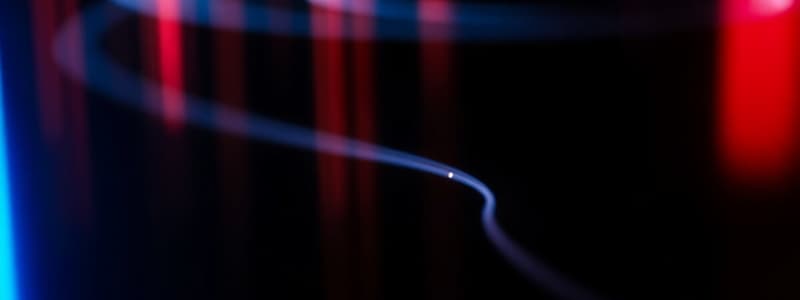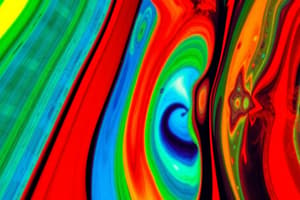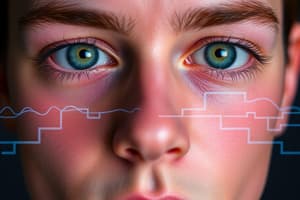Podcast
Questions and Answers
What is the definition of sensation in the context of sensory processing?
What is the definition of sensation in the context of sensory processing?
- The interpretation of raw sensory input by the brain.
- The process of detecting, converting, and transmitting sensory information. (correct)
- The experience resulting from assembling sensory data into patterns.
- The study of the relationship between physical stimuli and sensations.
What does the Absolute Threshold refer to in sensory perception?
What does the Absolute Threshold refer to in sensory perception?
- The maximum intensity required to notice a stimulus.
- The minimum stimulation needed to detect a stimulus 50% of the time. (correct)
- The threshold at which sensory adaptation occurs.
- The average level of sensitivity for all senses.
According to Weber’s Law, what does the Just Noticeable Difference (JND) represent?
According to Weber’s Law, what does the Just Noticeable Difference (JND) represent?
- The maximum change in stimulus intensity that can be perceived.
- The minimum difference between two stimuli that can be detected 50% of the time. (correct)
- The ability to detect different types of stimuli.
- The total sensory experience resulting from various inputs.
What aspect of psychophysics does the study of pressure and weight relate to?
What aspect of psychophysics does the study of pressure and weight relate to?
What is transduction in the sensory processing system?
What is transduction in the sensory processing system?
What is the primary purpose of Signal Detection Theory?
What is the primary purpose of Signal Detection Theory?
Which of the following best describes the relationship between kinesthesis and vestibular senses?
Which of the following best describes the relationship between kinesthesis and vestibular senses?
What is the primary cause of motion sickness according to the Sensory Conflict Theory?
What is the primary cause of motion sickness according to the Sensory Conflict Theory?
Which characteristic is NOT part of perceptual constancies?
Which characteristic is NOT part of perceptual constancies?
Which monocular depth cue involves the observation that parallel lines appear to converge in the distance?
Which monocular depth cue involves the observation that parallel lines appear to converge in the distance?
Flashcards
Sensation
Sensation
Detecting, converting, and transmitting raw sensory information from sense receptors to the brain.
Perception
Perception
Brain assembling raw sensory input into a meaningful experience.
Absolute Threshold
Absolute Threshold
Minimum stimulation needed to detect a stimulus 50% of the time.
Just Noticeable Difference (JND)
Just Noticeable Difference (JND)
Signup and view all the flashcards
Weber's Law
Weber's Law
Signup and view all the flashcards
Signal Detection Theory
Signal Detection Theory
Signup and view all the flashcards
Vestibular Sense
Vestibular Sense
Signup and view all the flashcards
Kinesthesis
Kinesthesis
Signup and view all the flashcards
Perceptual Constancy
Perceptual Constancy
Signup and view all the flashcards
Binocular Depth Cues
Binocular Depth Cues
Signup and view all the flashcards
Study Notes
Sensation and Perception
- Knowledge originates from perceptions.
- Sensation involves detecting, converting, and transmitting sensory information from sense organs to the brain.
- Senses include vision, hearing, smell, taste, touch, and internal body senses.
- Perception is the brain's interpretation of raw sensory input.
- Psychophysics studies the relationship between physical stimuli and sensations.
- Transduction converts physical energy into neural signals.
Sensation Thresholds
- Absolute Threshold: Minimum stimulation needed to detect a stimulus 50% of the time.
- Just Noticeable Difference (JND): Minimum difference between two stimuli detectable 50% of the time.
- Weber's Law: JND is a constant proportion of the original stimulus intensity, not a constant amount.
Signal Detection Theory
- Predicts how we detect signals in noise.
- Detection accuracy varies between individuals and even within individuals.
Somesthetic Senses
- Vestibular Sense: Balance and position in space.
- Kinesthetic Sense: Body position and movement.
- Touch (Somatosensory): pressure, warmth, cold, and pain.
Body Position and Movement
- Kinesthesis: Senses position and movement of body parts.
- Vestibular sense is the sense of balance, and head movement.
Vestibular System and Motion Sickness
- Motion sickness arises from a conflict between vestibular, visual, and body/motion sensations.
Vision and Audition
- Audition: Transduction of air pressure changes (sound waves) to neural impulses.
- Sound Waves: Oscillations of pressure in a medium.
- Amplitude: Perceived as loudness.
- Frequency: Perceived as pitch (hertz).
- Sound localization is based on slight differences in timing and intensity between ears.
Factors Influencing Perception
- Attention: Focusing awareness on specific stimuli.
- Selective attention focuses on one stimulus.
- Divided attention is split focus.
- Cocktail party effect: Ability to focus on one conversation among others,.
- Organization: Pattern recognition
- Expectations: Previous experiences influence perception.
- Motivation: Needs/desires affect perception.
- Inattentional blindness: The inability to perceive unexpected stimuli.
Perceptual Constancy
- Perceiving objects as unchanging even if retinal images change.
- Color constancy: Perceiving colors despite variations in lighting.
- Size constancy: Perceiving sizes despite distance changes.
- Shape constancy: Perceiving shapes despite changes in viewing angle.
Depth Perception
- Estimating distance and seeing in three dimensions.
- Monocular Depth Cues: Use of one eye information.
- Accomodation: Lens adjust for focusing at different distances.
- Pictorial depth cues: Use of monocular information including: linear perspective, relative size, relative height, interposition, texture gradient, and light and shadows
- Binocular Depth Cues: Use of both eyes information.
- Convergence: Eyes turn inward for near objects.
- Retinal disparity: Difference between two eyes' images, creating a 3D effect.
- Monocular Depth Cues: Use of one eye information.
The Visual Cliff
- Experiment by Eleanor Gibson to study depth perception in infants.
Studying That Suits You
Use AI to generate personalized quizzes and flashcards to suit your learning preferences.




